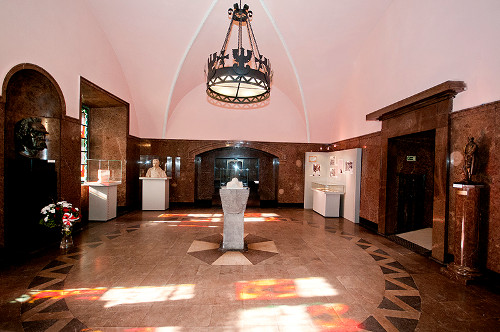 The Sanctuary of Marshal Joseph Pilsudski and the Museum of Polish Legions is situated in three ground-floor rooms of the Kielce Palace. The sanctuary was initiated with due ceremony on 2 October 1938 by Kielce province governor, dr Władysław Dziadosz – an ex-soldier of the 5th legions infantry regiment.
The Sanctuary of Marshal Joseph Pilsudski and the Museum of Polish Legions is situated in three ground-floor rooms of the Kielce Palace. The sanctuary was initiated with due ceremony on 2 October 1938 by Kielce province governor, dr Władysław Dziadosz – an ex-soldier of the 5th legions infantry regiment.
In August and September 1914 the palace became a headquarter of Józef Piłsudski, a seat of the Temporary Office of the Polish Army, a recruitment office, the print shop, editorial office of “Polish Army Official Journal”, field post office, a pass desk and a commissariat.
Architectural, painterly and sculpting design was entrusted to Stanisław Rzecki – a sculptor and Wacław Borowski – a painter. They did the adaptation work together with dr Andrzej Oleś – a provincial conservator and Wincenty Skuczyński – a sculptor. The concept of the Sanctuary arrangement was approved by the Artistic and Conservation Council of Kielce Town. Sanctuary had its own entrance from the southern yard. Above the sandstone portal there would be a coat of arms decorated with an eagle – a riflemen’s symbol, letter “S” and initials “JP”. The entrance is decorated with the medals of 1st Brigade: “For the faithful duty”, Legions’ Crosses and the general’s way line. Door handle is in the shape of the eagle’s head. Above the entrance there is hewed a quotation from the poem “Beniowski” by Juliusz Słowacki. Very similar symbols are used to decorate three windows in the western front of the palace.
At present one enters the Sanctuary through the entrance loggia in the main part of the palace. On the way one may admire permanent exposition “The Old European and Eastern Weaponry” situated in the former room of the Piłsudski’s aide-de-camp – Michał Fuksiewicz.
In the sanctuary - finally reconstructed in 1990 – original décor has been preserved: the marble floor and floor-covering, stucco ceiling decorations, bronze bust of the Marshal and the pedestal for his posthumous mask. The Piłsudski’s mask and uniform, the chandelier, stained glass windows and gates were renovated. From the former interior connected with legions the following things have been preserved: an external portal and an inscription from the Słowacki’s poem “Beniowski” above the former entrance to the Sanctuary, cartouches in the window frames, a commemorative plate and a maxim in the front loggia.
In the Flag Room (room of the Headquarter Commander lieutenant Mieczysław Trojanowski) there were presented copies of the flags of the Legions regiments: 1, 2, 3, 4, 5, 6 infantry regiment of Legions, 2 light artillery regiment, 2 light cavalry regiment, 2 lancer regiment. In 1938 the interiors were decorated with marble floor laid in chequered pattern, a cast-iron candlestick and a lot of legion symbols.
Central place in front of the entrance is occupied by the painting by Lvov painter Stanisław Batowski. The painting titled “The entry of the Piłsudski’s riflemen to Kielce” presents the moment of giving a welcome to Józef Piłsudski at Duża Street (John Paul II Street at present) on 12 August 1914. (Before the war the painting was a main part of the triptych that was situated in the Province Culture House.) Next to it there is a painting presenting a clash with Russian cavalry in front of the Bristol Hotel on Konstanty Street (Sienkiewicz Street at present). The third part – the riflemen’s fight near Karczówka – has been lost. The whole picture can be seen on the oil draft by the same author.
The tower – the chapel with representation of God’s Mother of Ostra Brama.
The last stage of the reconstruction was opening the chapel with representation of God’s Mother of Ostra Brama in the tower. The chapel was consecrated on 7th February 2005 by Kielce bishop Kazimierz Ryczan. On the altar there is situated a representation of God’s Mother of Ostra Brama, underneath there are four wrought iron candlesticks. Grey-blue wall colour has been reconstructed, as well as richly decorated chandelier. From the pre-war times a small window with characteristic glass framed with lead comes. Two remained windows probably were glassed in the same way.








